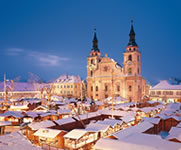
The Westerwald is a highland region between Frankfurt and Cologne, bordered by the Lahn, Sieg, Rhine and Dill rivers. This is a verdant walkers' paradise with wave after wave of forested peaks, as far as the eye can see. Farming, and the mining of iron ore, slate, basalt and clay, have helped to shape the Westerwald over the centuries. Although you sometimes can't see the water for all the trees, it is also a paradise for water babies of all ages. In the south of the Westerwald region, close to Hachenburg, is the Westerwald Lakes area, consisting of seven lakes surrounded by deciduous and coniferous forests, meadows and fields offering fun and activities for the whole family. Canoeing and rafting tours are very popular here. Every October, each of the lakes is drained. The fishing that takes place at this time gives cause for great celebrations by locals and visitors alikeTowards the end of the year, when the lakes freeze over, they provide a great temporary ice rink for skaters.

The Raiffeisenland region in the heart of the Rhine-Westerwald nature reserve is a fantastic recreation area with a whole host of leisure activities on offer. It is part of the Lower Westerwald forest and Rhenish-Westphalian Slate Mountains. An extensive network of footpaths leads through the varied countryside to a number of cultural monuments such as churches, abbeys, castle ruins, mills and the limes, the former border wall of the Roman Empire, all of which are worth a visit. Anyone with an interest in pottery-making should explore the Kannenbäckerland area around Höhr-Grenzhausen and Ransbach-Baumbach, where clay was once fired by the Romans. This region has the largest clay deposits in Europe. Today, amateur potters can still bake their own pots at one of the many potteries or watch demonstrations at the modern automated factories. Pottery courses are also on offer all year round. The ceramics museum in Höhr-Grenzhausen documents the history of pottery-making and the ceramics industry.







